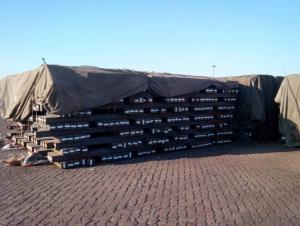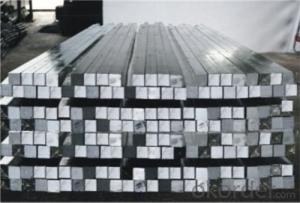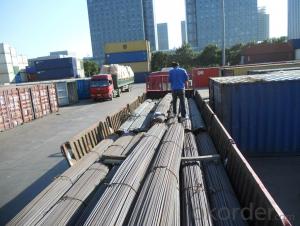Hot Rolled Square Carbon Steel Bar Material Q195
- Loading Port:
- Qingdao
- Payment Terms:
- TT or LC
- Min Order Qty:
- 25 m.t.
- Supply Capability:
- 3000 m.t./month
OKorder Service Pledge
OKorder Financial Service
You Might Also Like
Product Description:
OKorder is offering Hot Rolled Square Steel Barat great prices with worldwide shipping. Our supplier is a world-class manufacturer of steel, with our products utilized the world over. OKorder annually supplies products to European, North American and Asian markets. We provide quotations within 24 hours of receiving an inquiry and guarantee competitive prices.
Product Applications:
The Square Steel is normally used as structure steel.
Row material for other structure steel like steel angles, channels, I-beams, H-beams, etc…
Product Advantages:
OKorder's Hot Rolled Square Steel Bar Material Q195 are durable, strong, and resist corrosion.
Main Product Features:
· Premium quality
· Prompt delivery & seaworthy packing (30 days after receiving deposit)
· Corrosion resistance
· Can be recycled and reused
· Mill test certification
· Professional Service
· Competitive pricing
Product Specifications:
Length of a side(mm) | Theoretical weight(kg/m) | Length of a side(mm) | Theoretical weight(kg/m) |
6 | 0.283 | 32 | 8.04 |
7 | 0.385 | 33 | 8.55 |
8 | 0.502 | 34 | 9.07 |
9 | 0.636 | 35 | 9.62 |
10 | 0.785 | 36 | 10.17 |
11 | 0.950 | 38 | 11.24 |
12 | 1.13 | 40 | 12.56 |
13 | 1.33 | 42 | 13.85 |
14 | 1.54 | 45 | 15.90 |
15 | 1.77 | 48 | 18.09 |
16 | 2.01 | 50 | 19.63 |
17 | 2.27 | 53 | 22.05 |
18 | 2.54 | 55 | 23.6 |
19 | 2.82 | 56 | 24.61 |
20 | 3.14 | 58 | 26.4 |
21 | 3.46 | 60 | 28.26 |
22 | 3.80 | 63 | 31.16 |
23 | 4.15 | 65 | 33.17 |
24 | 4.52 | 68 | 36.3 |
25 | 4.91 | 70 | 38.49 |
26 | 5.30 | 75 | 44.16 |
27 | 5.72 | 80 | 50.24 |
28 | 6.15 | 85 | 56.72 |
29 | 6.60 | 90 | 63.59 |
30 | 7.06 | 95 | 70.85 |
31 | 7.54 | 100 | 78.50 |
Notes:
1, The theoretical weights in the list, base on the density of 7.85 g/cm3.
2, The numbers with mean that they are not regulars or we don’t offer them.
-List 2. The allowed tolerance of Square Steel:
Length of a side(mm) | Allowed Tolerance | ||
Group1 | Group2 | Group3 | |
5.5~7 | ±0.20 | ±0.30 | ±0.40 |
7~20 | ±0.25 | ±0.35 | ±0.40 |
20~30 | ±0.30 | ±0.40 | ±0.50 |
30~50 | ±0.40 | ±0.50 | ±0.60 |
60~80 | ±0.60 | ±0.70 | ±0.80 |
80~110 | ±0.90 | ±1.0 | ±1.1 |
110~150 | ±1.2 | ±1.3 | ±1.1 |
150~190 | ―― | ―― | ±2.0 |
190~250 | ―― | ―― | ±2.5 |
Chemical Composition:
Standard | Grade | Element (%) | ||||
GB | Q195 | C | Mn | S | P | Si |
≤0.12 | ≤0.50 | ≤0.04 | ≤0.035 | ≤0.3 | ||
-Method of deoxidation: F, b, Z
Usage/Applications of Square Steel:
-The Square Steel is normally used as structure steel.
-Row material for other structure steel like steel angles, channels, I-beams, H-beams, etc…
Packaging & Delivery of Square Steel:
-Packing Detail: The products can be packed in bundles by steel wires.
-Delivery Detail: 30~45 working days after receive buyer’s T.T. or L/C.
Transportation & Marking:
-Transportation:
1, The products can be delivered by bulk vessel or by container.
2, The maximum quantity of loading of container is 25 tons.
3, The products usually are transported to the nearest port from the production place.
-Marks:
1, Color mark: there will be color marking on both ends of the bundles for the cargo delivered by bulk vessel. That makes is easily to distinguish at the destination port.
2, Tag mark: the tag marks will be tied up to each bundle. The information is usually including supplier’s logo and name, product name, made in China, products’ specifications and other information requested by customers.
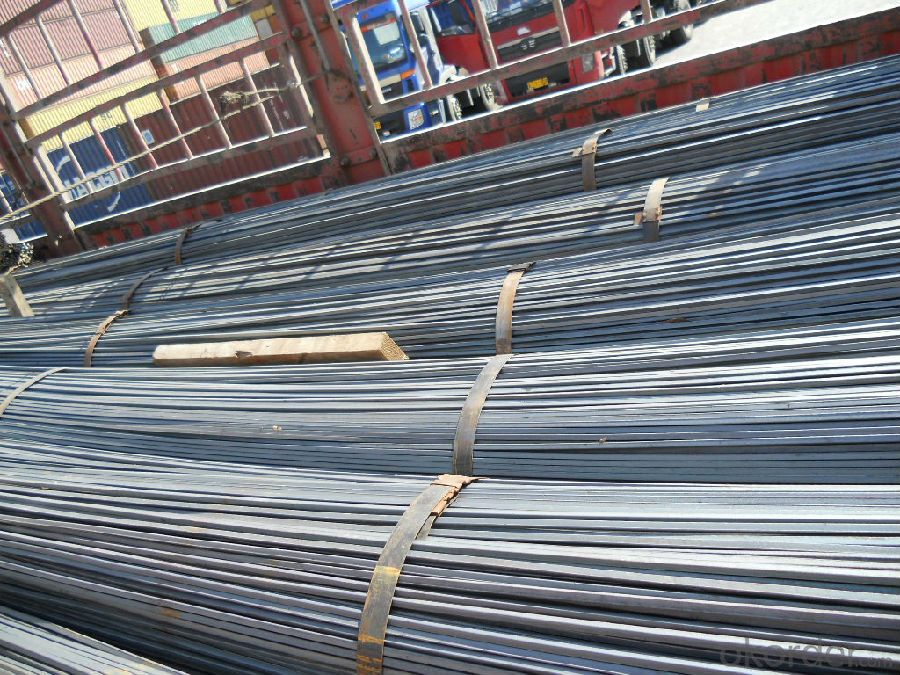
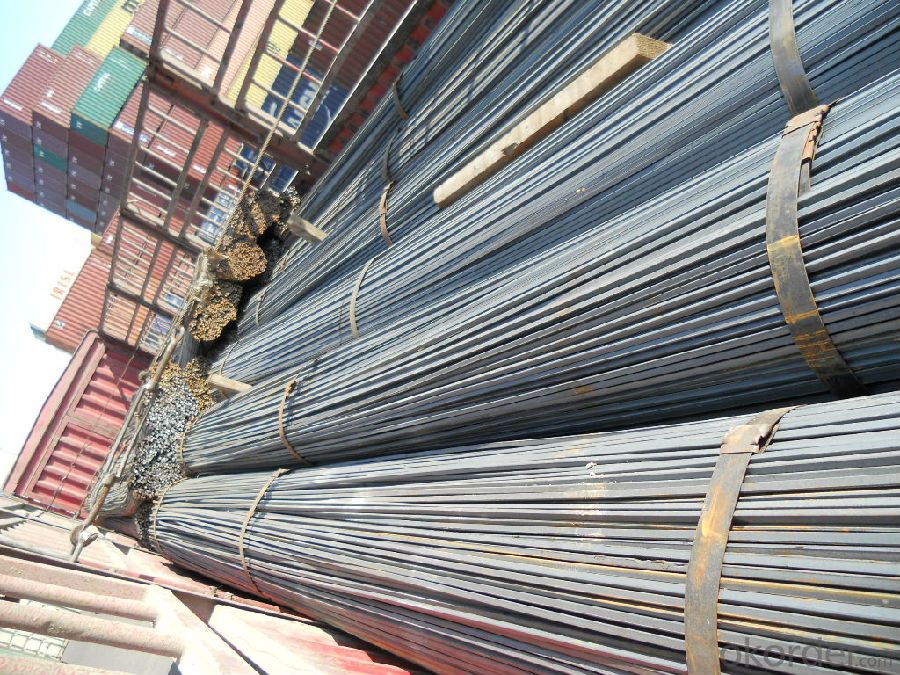
FAQ:
Q1: Why buy Materials & Equipment from OKorder.com?
A1: All products offered byOKorder.com are carefully selected from China's most reliable manufacturing enterprises. Through its ISO certifications, OKorder.com adheres to the highest standards and a commitment to supply chain safety and customer satisfaction.
Q2: How do we guarantee the quality of our products?
A2: We have established an advanced quality management system which conducts strict quality tests at every step, from raw materials to the final product. At the same time, we provide extensive follow-up service assurances as required.
Q3: How soon can we receive the product after purchase?
A3: Within three days of placing an order, we will begin production. The specific shipping date is dependent upon international and government factors, but is typically 7 to 10 workdays.
Q4: What makes stainless steel stainless?
A4: Stainless steel must contain at least 10.5 % chromium. It is this element that reacts with the oxygen in the air to form a complex chrome-oxide surface layer that is invisible but strong enough to prevent further oxygen from "staining" (rusting) the surface. Higher levels of chromium and the addition of other alloying elements such as nickel and molybdenum enhance this surface layer and improve the corrosion resistance of the stainless material.
- Q:Can a steel square be used for roof truss layout and construction?
- Yes, a steel square can be used for roof truss layout and construction. A steel square, also known as a framing square or carpenter's square, is a versatile tool that is commonly used in the construction industry for various tasks, including roof truss layout. A steel square consists of two arms that meet at a right angle, forming a 90-degree corner. One arm is longer than the other, typically 24 inches long, and is used for measuring and marking straight lines. The shorter arm, usually 16 inches long, is used for measuring and marking angles. When it comes to roof truss layout, a steel square can be used to determine and mark the angles for the truss members. It can be used to layout the pitch or slope of the roof, ensuring that the trusses are properly aligned and positioned. Additionally, a steel square can also be used for cutting and marking the truss members. It can be used to mark the angles for the cuts, ensuring that the truss members fit together accurately. The longer arm can be used to measure and mark the length of the truss members, ensuring that they are cut to the correct size. Overall, a steel square is a valuable tool for roof truss layout and construction. Its versatility and accuracy make it an essential tool for carpenters and construction professionals working on roof truss projects.
- Q:Can a steel square be used for concrete formwork?
- Yes, a steel square can be used for concrete formwork. Steel squares are commonly used in construction for marking and measuring angles, as well as ensuring accurate right angles. When it comes to concrete formwork, steel squares can be used to ensure that the forms are set at right angles and that they are properly aligned. Additionally, steel squares are durable and have a high strength-to-weight ratio, making them suitable for heavy-duty applications like concrete formwork. However, it is important to note that steel squares should be properly cleaned and maintained to prevent rusting and ensure their longevity.
- Q:What are some common applications of a steel square in metalworking?
- A steel square, also known as a framing square or a carpenter's square, is a versatile tool that finds numerous applications in metalworking. Some common uses of a steel square in metalworking include: 1. Measuring and marking: Steel squares are used for measuring and marking straight lines, angles, and dimensions on metal sheets or bars. They provide precise measurements and ensure accurate cuts or bends. 2. Squaring: Steel squares are essential for ensuring the accuracy of right angles. They can be used to check if two edges of a metal piece are perpendicular to each other or to create 90-degree angles when fabricating metal structures. 3. Laying out patterns: Steel squares are often used to lay out patterns on metal surfaces. By utilizing the various scales and markings on the square, metalworkers can create complex patterns or templates for cutting or bending metal. 4. Guiding cuts: Steel squares can be used as guides for making straight cuts with tools like saws or shears. By aligning the square with the cutting line, metalworkers can ensure a straight and accurate cut. 5. Checking flatness: Steel squares can be used to check the flatness of a metal surface. By placing the square against the metal and observing if there are any gaps or light passing through, metalworkers can determine if the surface is flat or needs further adjustments. 6. Marking angles: Steel squares come with angle markings that allow metalworkers to measure or mark specific angles accurately. This is particularly useful for creating precise bevels or chamfers on metal edges. 7. Layout and framing: Steel squares are commonly used for layout and framing purposes in metalworking. They help metalworkers plan and construct frameworks, ensuring that all corners and joints are properly aligned. 8. Aligning and assembling: Steel squares can be used to align and assemble metal components. By utilizing the square's straight edge, metalworkers can ensure that parts are joined accurately and securely. Overall, a steel square is a fundamental tool in metalworking that assists with measuring, marking, squaring, cutting, and aligning metal pieces. Its versatility and precision make it an essential tool for both professional metalworkers and DIY enthusiasts.
- Q:Can a steel square be used for layout work?
- Yes, a steel square can be used for layout work. Steel squares, also known as combination squares, are versatile tools that are commonly used in woodworking and metalworking for laying out and measuring angles, checking for squareness, and marking straight lines. They typically have a 90-degree angle along one edge and a sliding or adjustable head that can be set at different angles to accurately measure and mark angles other than 90 degrees. The steel construction of the square ensures durability and accuracy, making it a reliable tool for layout work.
- Q:How do you use a steel square to determine the length of a fence?
- To use a steel square to determine the length of a fence, you would need to follow a few simple steps. First, find a flat and level surface where you can measure the fence accurately. Place the steel square on the ground or a sturdy table. Next, position one arm of the steel square against the fence post or any fixed point on the fence. Ensure that it is aligned perpendicular to the fence line. The other arm of the square should be extended along the fence line. Now, move the square along the fence line, keeping the arms aligned with the fence and perpendicular to each other. As you move, count the number of times you have to move the square's position to reach the end of the fence. Each time you move the square, mark the spot where the extended arm reaches. Once you reach the end of the fence, count the number of marks you made. Multiply this number by the length of one side of the square to obtain the total length of the fence. For example, if the length of one side of the square is 12 inches, and you made 20 marks, the total length of the fence would be 20 x 12 = 240 inches or 20 feet. Using a steel square in this manner allows for accurate measurements and helps ensure that the fence is straight and properly aligned.
- Q:What are some common applications for a steel square in stair construction?
- Some common applications for a steel square in stair construction include measuring and marking the angles for cutting stair stringers, determining the rise and run of each step, checking the levelness and squareness of the stairs, and ensuring accurate and precise construction of the stair components.
- Q:How do you use a steel square to create cove cuts?
- To create cove cuts using a steel square, one must first prepare the workpiece and gather the necessary tools. Cove cuts are typically made on a table saw, so it is important to have a suitable blade for the task. To begin, mark the desired cove profile on the edge of the workpiece using either a pencil or a marking knife. This will ensure a clear and precise line. Next, position the steel square on the table saw, aligning one edge with the blade. The square should be perpendicular to the blade and parallel to the miter gauge slots. Adjust the blade height to the desired depth of the cove cut. It is recommended to start with a shallow cut and increase the depth gradually if necessary. Hold the workpiece firmly against the steel square, ensuring that the marked cove line is aligned with the blade. Use clamps or a push stick to maintain a safe distance from the blade while guiding the workpiece. Turn on the table saw and slowly push the workpiece through the blade, following the cove line. It is important to take your time and maintain a steady pace to achieve a smooth and accurate cut. Once the initial cove cut is complete, additional passes may be necessary to achieve the desired depth and smoothness. Simply adjust the blade height accordingly and repeat the process. After completing the cove cuts, carefully inspect the workpiece to ensure the desired shape and quality. If necessary, sand or file any rough edges to achieve a finished look. Remember to prioritize safety while using power tools. Wear appropriate protective gear, such as safety glasses and hearing protection, and follow the manufacturer's instructions for your specific table saw model.
- Q:What are the different techniques for using a steel square in metalworking welding?
- There are several techniques for using a steel square in metalworking welding. One common technique is using the steel square as a guide for making accurate right-angle cuts. The square can be placed against the metal surface and used as a reference to guide the cutting tool, ensuring precise and straight cuts. Another technique is using the steel square as a measuring tool. The square has markings and measurements on its blade, which can be used to measure and mark accurate dimensions on the metal surface. This is particularly useful when fabricating or fitting metal pieces together. The steel square can also be used as a guide for welding joints at right angles. By positioning the square on the metal surface, it can serve as a reference for aligning the welding torch or electrode, ensuring that the weld is performed evenly and at the desired angle. In addition, the steel square can be utilized for checking the squareness and flatness of welded joints. By placing the square against the welded joint, any deviations from a true right angle can be identified and corrected. Similarly, the square can be used to check the flatness of a metal surface, ensuring that it is even and free from any imperfections. Overall, the steel square is a versatile tool in metalworking welding, serving as a guide for accurate cuts, measurements, alignment, and quality control. Its precise design and functionality make it an essential tool for welders who strive for precision and accuracy in their work.
- Q:Can a steel square be used for measuring door and window openings?
- Yes, a steel square can be used for measuring door and window openings. A steel square, also known as a framing square or carpenter's square, is a versatile tool commonly used in construction and carpentry. It typically has a 90-degree angle and a longer blade that is used for measuring and marking straight lines. The shorter blade can be used to measure angles, such as 45 degrees or 30 degrees. When measuring door and window openings, a steel square can be used to ensure accurate and square measurements. It can be placed against the edges of the opening to check if they are perfectly perpendicular or if any adjustments need to be made. The longer blade can be used to measure the width and height of the opening, while the shorter blade can be used to check if the corners are square. Overall, a steel square is a reliable tool that can be used for measuring door and window openings and ensuring they are properly aligned and square.
- Q:What are some common techniques for using a steel square in cabinetry?
- A steel square, also known as a framing square or carpenter's square, is a versatile tool commonly used in cabinetry for measuring and marking angles, ensuring accurate cuts and joinery. Here are some common techniques for using a steel square in cabinetry: 1. Checking for squareness: One of the primary uses of a steel square is to check if a corner is perfectly square. Place the square against the inside corner, and if the edge aligns with the adjacent edge, the corner is square. This helps in ensuring all corners of the cabinets are at right angles. 2. Marking 45-degree cuts: The steel square has a 45-degree angle marked on its body. By aligning the square with the edge of the material, you can mark a precise 45-degree angle for mitered cuts, such as for trim or decorative elements on cabinet doors and panels. 3. Marking parallel lines: The long edge of a steel square is used for marking parallel lines. Simply align the square with the edge of the material and draw a line along the other edge of the square. This technique is helpful for marking shelf and cabinet bottom locations or ensuring parallel cuts. 4. Laying out cuts: The steel square is excellent for marking accurate lines for cuts. By aligning the square with the edge of the material, you can draw a line perpendicular or parallel to the edge. This helps in marking cuts for cabinet components like shelves, drawer dividers, and door frames. 5. Determining pitch and slope: A steel square can be used to determine the pitch or slope of a roof or any inclined surface. By placing the square on the surface, you can read the pitch or slope degree based on the markings on the square. 6. Measuring and transferring dimensions: The steel square can also be used as a ruler for measuring and transferring dimensions. The body of the square usually has a scale on one or both edges, allowing you to measure and mark precise lengths or distances. Overall, a steel square is an indispensable tool in cabinetry, offering accuracy and versatility in measuring, marking, and verifying angles. Whether you're building cabinets from scratch or making precise modifications, incorporating these common techniques will help ensure your cabinetry projects are precise and well-crafted.
1. Manufacturer Overview |
|
|---|---|
| Location | |
| Year Established | |
| Annual Output Value | |
| Main Markets | |
| Company Certifications | |
2. Manufacturer Certificates |
|
|---|---|
| a) Certification Name | |
| Range | |
| Reference | |
| Validity Period | |
3. Manufacturer Capability |
|
|---|---|
| a)Trade Capacity | |
| Nearest Port | |
| Export Percentage | |
| No.of Employees in Trade Department | |
| Language Spoken: | |
| b)Factory Information | |
| Factory Size: | |
| No. of Production Lines | |
| Contract Manufacturing | |
| Product Price Range | |
Send your message to us
Hot Rolled Square Carbon Steel Bar Material Q195
- Loading Port:
- Qingdao
- Payment Terms:
- TT or LC
- Min Order Qty:
- 25 m.t.
- Supply Capability:
- 3000 m.t./month
OKorder Service Pledge
OKorder Financial Service
Similar products
New products
Hot products
Related keywords
